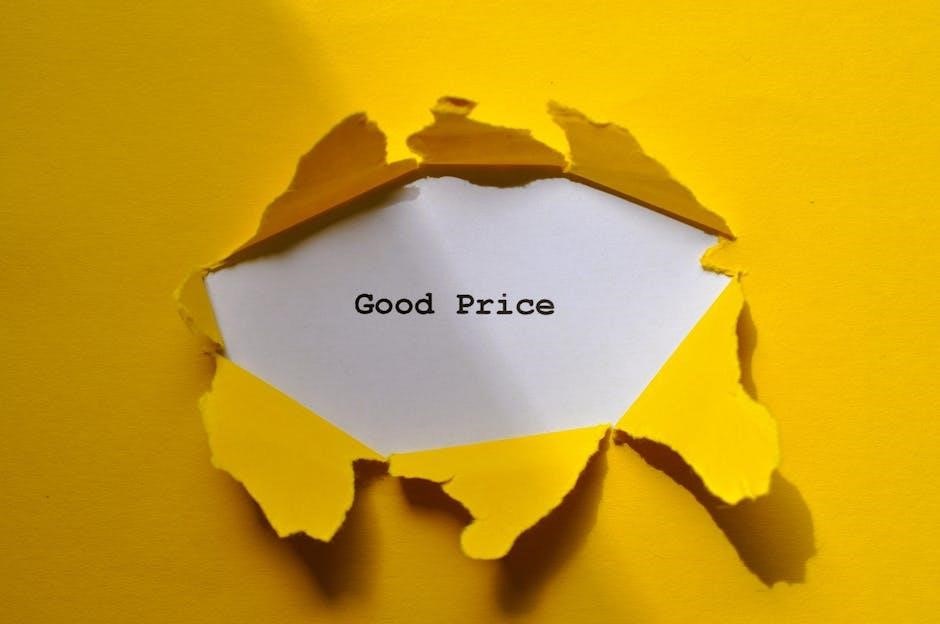
graphic design fees and pricing guide pdf
This comprehensive guide provides insights into graphic design pricing, covering models like hourly rates, project-based, and retainer fees. It helps designers and clients understand fair pricing.
Understanding Graphic Design Pricing Models
Explore the key pricing models in graphic design, including hourly rates, project-based fees, and retainer agreements, to find the best fit for your design needs.
Hourly Rate Pricing
Hourly rate pricing is a common model where designers charge clients based on the time spent on a project. Rates vary widely, typically ranging from $25 to $150 per hour, depending on experience, location, and expertise. This model is ideal for projects with unpredictable scopes or ongoing work. Clients benefit from transparency, as they only pay for the time spent. However, it requires trust and clear communication to avoid disputes. Designers often track hours using tools like Toggl or Harvest; This method is popular for freelance graphic designers, as it offers flexibility and fair compensation for their time and skills.
Project-Based Pricing
Project-based pricing involves charging a fixed fee for a specific scope of work, providing clients with clear upfront costs. This model is popular for its transparency and predictability. Designers estimate the time required for the project, multiply it by their hourly rate, and add any additional expenses. For example, a logo design might cost between $300 and $1,500, depending on complexity. This approach is ideal for well-defined projects, as it eliminates the risk of scope creep and ensures clients know exactly what they’re paying for. It also motivates designers to work efficiently, aligning their interests with client satisfaction.
Retainer Pricing
Retainer pricing involves a recurring fee for ongoing graphic design services, ensuring a steady workflow for designers and consistent support for clients. This model is ideal for businesses requiring regular design work, such as brands or agencies. Clients pay a fixed monthly rate, which grants them access to a predetermined number of hours or specific services. For example, a retainer might include logo updates, social media assets, or brochure designs. This approach provides predictable costs for clients and stable income for designers, fostering long-term partnerships. Retainer pricing is scalable, adapting to the evolving needs of clients while ensuring continuous creative support.

Common Graphic Design Services and Their Costs
Graphic design services include logo creation, web design, print materials, and digital graphics. Costs vary widely, from $100 for basic logos to $5,000+ for complex websites.
Logo Design Pricing
Logo design pricing varies widely, ranging from $100 for basic designs to $2,500 or more for complex, custom logos. The cost depends on the designer’s experience, the complexity of the design, and the number of revisions included. Freelance designers and small agencies often charge between $300-$1,500, while high-end firms may charge upwards of $5,000. Some designers offer tiered packages, starting with simple designs and increasing in price for more detailed work. It’s important to align your budget with your expectations for the final product, as higher prices typically reflect more time, creativity, and expertise invested in the design.
Web Design Pricing
Web design pricing varies significantly based on the project’s complexity and scope. Basic websites with a few pages typically cost between $500 and $2,000, while custom or e-commerce sites can range from $3,000 to $10,000 or more. Factors influencing costs include the use of CMS platforms like WordPress, responsive design requirements, and the need for advanced features such as payment gateways or custom integrations. Some designers charge hourly, while others prefer project-based pricing. Additional costs may include domain registration, hosting, and ongoing maintenance, which can be bundled into a retainer package for long-term support;
Print Design Pricing (Brochures, Posters, etc.)

Print design pricing varies based on the complexity and size of the project. A standard brochure design typically costs between $300 and $1,200, while a more intricate design with multiple pages or folds can range from $800 to $2,500. Posters generally fall between $200 and $800, depending on the size and detail. Additional costs may include printing expenses, which vary by material and quantity. Factors like the number of revisions, design elements, and the designer’s expertise also influence the final price. Print design projects often use project-based pricing, ensuring clients pay for the specific scope of work agreed upon.
Digital Graphics Pricing (Infographics, Social Media Assets, etc.)

Digital graphics pricing varies widely depending on the type and complexity of the project. Infographics typically range from $100 to $500, while social media assets, such as posts or stories, can cost between $50 and $200 per design. Animated graphics or more intricate designs may fall between $300 and $1,500. Factors like the number of revisions, design elements, and the designer’s expertise influence the cost. Additional services, such as optimizing for different platforms or creating multiple variations, may incur extra fees. Digital graphics are often billed on a project basis, ensuring clients pay for the specific deliverables agreed upon.
Factors Influencing Graphic Design Fees
Designer expertise, project complexity, location, and market rates significantly impact graphic design fees. Industry standards and trends also play a crucial role in determining final costs.
Designer Experience and Expertise
A designer’s experience and expertise significantly influence graphic design fees. Seasoned professionals with a strong portfolio and specialized skills often charge higher rates due to the quality and efficiency they bring. Experience ensures better understanding of client needs, faster turnaround times, and higher-quality outputs. Expertise in specific design niches, such as branding or web design, can also command premium pricing. Clients are generally willing to pay more for designers who can deliver polished, professional results consistently. This makes experience a key factor in determining fair and competitive graphic design fees.
Project Complexity and Scope
Project complexity and scope directly impact graphic design fees. Larger, more intricate projects, such as multi-page brochures or detailed infographics, require more time and resources, increasing costs. The number of revisions, design elements, and overall scale of the project influence pricing. For example, a folded trifold brochure with six pages costs more than a simple bifolding design. Additionally, projects requiring specialized skills or tight deadlines may incur higher fees. Designers often estimate time based on the project’s scope and apply their hourly rate to determine the final cost. This ensures clients pay fairly for the work involved.
Location and Market Rates
Location significantly influences graphic design fees, as rates vary by region and market demand. Designers in urban areas, such as New York or London, often charge higher rates due to the cost of living and competitive markets. Conversely, designers in smaller cities or developing countries may offer lower prices. Global market rates also play a role, with freelance platforms showcasing a wide range of pricing based on geographic location. Understanding local market standards helps clients and designers set realistic expectations and ensures fair pricing aligned with regional economic conditions. This geographic variation is a key factor in determining design service costs.
Industry Standards and Trends
Industry standards and trends play a crucial role in shaping graphic design fees. The guide highlights current pricing benchmarks for services like logo design, web graphics, and print materials. It covers over 110 services, providing clear cost ranges to ensure transparency. Updated for 2025, the guide reflects market shifts, such as increased demand for digital assets and the rise of value-based pricing. By understanding these standards, designers and clients can align expectations and ensure fair compensation. The guide also emphasizes adapting to trends, like outsourcing and retainer models, to remain competitive in a dynamic market. This insights help both parties make informed decisions.

How to Budget for Graphic Design Services
Assess your design needs and set a realistic budget by understanding project scope, complexity, and designer expertise. This ensures fair pricing and value for your investment.
Setting a Realistic Budget for Your Design Needs
Assess your design requirements and understand the project scope to set a realistic budget. Consider factors like complexity, revisions, and designer expertise to avoid cost overruns; This approach ensures your budget aligns with your business goals and delivers value.
Start by identifying essential services and prioritize them. Consider scalability to adjust as needs evolve. Remember, quality often justifies higher costs, so balance affordability with expertise. Use a detailed pricing guide to plan accurately and make informed decisions.
Understanding Value vs. Cost in Graphic Design
Understanding the difference between value and cost is crucial in graphic design. While cost focuses on the price paid, value considers the long-term benefits and quality of the work. High-quality designs often justify higher costs by delivering better results and brand enhancement. It’s important to evaluate what you’re getting for your money, ensuring the design meets your goals and resonates with your audience.
Compare the expertise, experience, and ability to meet deadlines when assessing value. A higher cost may reflect superior craftsmanship, while a lower cost might compromise quality. Prioritize value to achieve lasting impact and avoid costly revisions later.

Strategies for Freelance Graphic Designers to Increase Earnings
Freelancers can boost earnings by setting competitive rates, offering value-based pricing, and negotiating retainers or long-term contracts, ensuring consistent income and client satisfaction.
Pricing Based on Value Delivered
Pricing based on value delivered focuses on the impact of the design work rather than the time spent. This approach aligns fees with the project’s goals and outcomes, ensuring clients pay for results. For example, a logo design that becomes a brand icon justifies higher rates due to its long-term value. By understanding the project’s significance, designers can set rates that reflect the worth they bring, fostering mutual satisfaction. This method encourages transparency and trust, as clients see direct correlations between costs and benefits, making it a win-win for both parties involved in the design process.
Negotiating Contracts and Retainer Deals
Negotiating contracts and retainer deals requires clear communication and alignment of expectations. Designers should outline deliverables, timelines, and payment terms to ensure transparency. Retainer deals offer stability, providing a steady income stream while allowing clients consistent access to design services. When negotiating, focus on the value you bring, such as expertise and reliability. Consider tiered pricing or flexible terms to meet client needs while ensuring fair compensation. Regularly reviewing and adjusting contracts ensures both parties remain satisfied. Effective negotiation builds long-term partnerships, benefiting both designers and clients by fostering trust and mutual understanding in the graphic design process.

Real-World Examples of Graphic Design Pricing
Explore real-world examples of graphic design pricing, such as logo designs starting at $500, web designs from $2,000, and print materials like brochures at $1,500 each.
Case Studies of Successful Pricing Strategies
One designer doubled earnings by switching to value-based pricing for logo designs, charging $2,000-$5,000 based on brand impact. Another secured a $3,000/month retainer for ongoing web graphics. A studio simplified client budgets by offering tiered packages for print materials, ensuring transparency. These strategies highlight how aligning pricing with client value and project scope fosters trust and long-term partnerships, benefiting both designers and clients alike.
Comparing Pricing Across Different Design Platforms
Design platforms vary significantly in pricing structures. Upwork freelancers charge $25-$150/hour, while Fiverr sellers offer logo designs starting at $5 but can go up to $1,500. Toptal designers, known for premium services, often charge $100-$250/hour. Platforms like 99designs host contests where clients set budgets, ranging from $299 for basic logos to $1,299 for premium packages. These comparisons highlight how platform target audiences and service levels influence pricing, helping clients and designers choose the best fit for their needs and budgets.
Graphic Design Pricing Guide PDF: Key Takeaways
Industry standards, best practices, and clear communication are essential for fair pricing. This guide ensures designers and clients align on expectations, fostering transparency and successful collaborations.
Industry Standards for Graphic Design Fees
Industry standards for graphic design fees vary based on experience, location, and project complexity. Hourly rates typically range from $25 to $150, while project-based pricing can start at $100 for simple tasks like logo design, reaching up to $5,000 or more for complex projects. Print design, such as brochures, often costs between $300 and $1,500, depending on the scope. Digital graphics, including infographics and social media assets, may range from $200 to $1,000. These standards ensure fair compensation for designers while providing clients with transparent pricing. Staying updated on these benchmarks helps both parties navigate pricing negotiations effectively.
Best Practices for Clients and Designers
Clear communication is essential for successful collaborations. Clients should provide detailed project scopes to ensure accurate pricing, while designers should offer transparent fee structures. Regular updates and feedback sessions help maintain alignment. For clients, understanding the value of custom design over generic templates is crucial. Designers should educate clients on industry standards and the time required for quality work. Both parties benefit from written agreements outlining deliverables, timelines, and payment terms. Asking questions and addressing concerns early prevents misunderstandings. By fostering trust and mutual respect, clients and designers can achieve fair, satisfactory outcomes that meet creative and financial expectations. Open dialogue ensures long-term success.
Mastering graphic design pricing involves understanding models, balancing cost and value, and clear communication. This ensures fair, competitive rates and successful outcomes for both designers and clients.
Final Tips for Fair and Competitive Pricing
For fair pricing, consider project scope, time, and client budget. Offer tiered packages to cater to different needs. Clearly communicate value to justify rates. Regularly review market trends to stay competitive. Avoid underpricing to maintain professionalism and profitability. Use contracts to outline expectations and protect both parties. Provide exceptional service to build long-term relationships and referrals. Stay transparent about costs and revisions. Invest in continuous learning to enhance skills and justify higher rates. By balancing fairness and competitiveness, designers can attract clients while sustaining a profitable business.